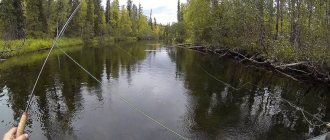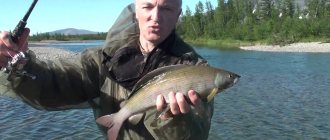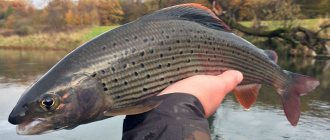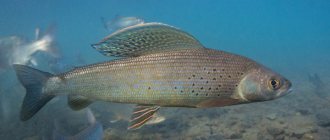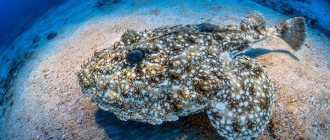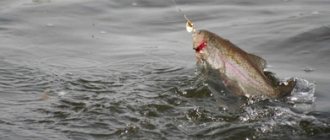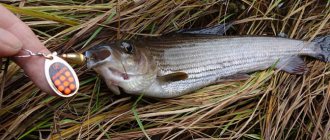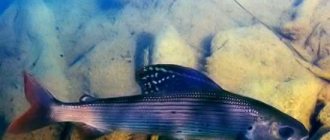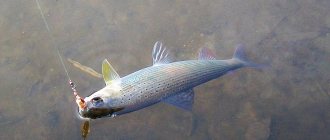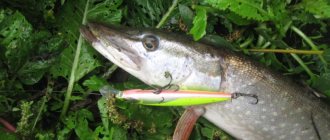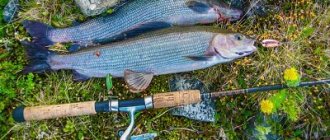Appearance
The body shape is elongated. The head is small and narrow. The eyes are bulging and round. The mouth is small. The back is dark gray, with black spots, the sides are silvery, the belly is light gray or, occasionally, yellow.
The color depends on the species, but it is always variegated. The intensity of color depends on the habitat of the fish: in large rivers they are lighter, in small rivers they are darker.
The reproductive cycle is also reflected in appearance: during the spawning period, mature fish become bright, and juvenile grayling acquires the striated color that fry have.
The main distinguishing feature of grayling, thanks to which this fish cannot be confused with any other, is the high and long dorsal fin, decorated with reddish spots and turquoise-violet stripes. When folded, its end reaches the beginning of the tail. Between them is a family sign - a small adipose fin. The color of the caudal fin is similar to the dorsal fin, but its general shade, like that of the anal fin, is red-burgundy.
European grayling
European grayling
— Thymallus thymallus Linnaeus, 1758
Population:
Populations of the river basins of the upper Volga and Ural
Rarity category:
2 – declining populations of a widespread species.
Spreading:
The species' range covers Europe from France and England to the west. up to rr. Kara and Ural to the east. and from r. Danube in the south to the Barents Sea in the north. Bass inhabits Russia. rivers flowing into the Baltic, Barents, White and Kara seas, bass. the upper and middle Volga (including the Kama basin) and the basin. R. Ural [1]. In the bass. Oki disappeared. In the bass. R. The Urals are currently preserved only on the territory of Russia [2] in several right-bank tributaries of the river. Ural (basin rivers Bolshoi Yushatyr, Bolshoi Ik and Sakmara) [3,4]. In the bass. the upper Volga is found in Tver, Moscow, Yaroslavl, Kostroma, Vologda and, possibly, Ivanovo regions. (disappeared in the Nizhny Novgorod region) [5,6]; in the bass R. The Urals are in the Republic of Bashkortostan, Orenburg and, possibly, Chelyabinsk regions.
Habitat:
Prefers bodies of water with clean and cold water; more often found in rivers and streams, less often in lakes. There are river, stream and lake ecotypes of grayling [7,8]; Currently, mainly the stream ecotype has been preserved, which more easily adapts to anthropogenic impacts than others and is represented by a number of small populations isolated from each other [4,9,10]. It differs from the river and lake ecotypes in earlier sexual maturation (at the age of 1+-2+), small size (length does not exceed 24 cm, weight 150 g), low absolute fecundity (does not exceed 2 thousand eggs) [8-10] , the diet is dominated by insects falling into the water; in the river and lake ecotypes, adult individuals have a length of 30-50 cm, a weight of 0.5-1.0 kg, and absolute fecundity reaches 36 thousand eggs. River populations exhibit pronounced homing [11]. All ecotypes spawn in May at currents and shallow depths. Eggs are deposited on hard ground.
Number:
Decline in the number of populations of European grayling in the basin. Volga was noted back in the 19th century. [9,12]; before that, it disappeared in the middle reaches of the Oka River [13]. In the bass. R. The Ural also lived in the left-bank tributaries in the past, where it is absent now [4]. The reduction and disappearance of individual populations primarily affects the large form (river and lake ecotypes). The small form (stream ecotype), due to its small size (not so attractive for fishermen) and short-cycle nature (the rate of reproduction increases), more successfully resists anthropogenic impact and therefore persists in a number of places [9,14]. Apparently, only the stream ecotype is able to withstand intense anthropogenic impact, which contributes to the formation of short-cycle populations consisting of small individuals; this allows the species to survive, but its gene pool is apparently depleted [8,9]. The stream ecotype is represented by isolated, small populations living in streams, rivers and upper reaches of rivers. The size of individual populations, apparently, does not exceed several thousand producers. The main limiting factors are intensive fishing by the local population [4,5,10,12], pollution of rivers and streams by various runoff [4,14].
Security:
It is necessary to conduct an inventory of surviving populations and assess their current state, carry out cryopreservation of genomes, and organize specially protected natural areas in the habitats of endangered populations, in particular in bass. R. Katraly (Orenburg region) and in the basin. R. Lutosni (Moscow region) [4,10].
Source:
1. Berg, 1948; 2. Fishes of Kazakhstan, 1986; 3. Red Book of the Bashkir Autonomous Soviet Socialist Republic, 1987; 4. Red Book of the Orenburg Region, 1998; 5. Puzanov et al., 1955; 6. Kuznetsov et al., 1974; 7. Korotaeva, Zinoviev, 1992; 8. Zinoviev, 1992; 9. Zinoviev, 1985; 10. Zinoviev
Compiled by:
N.I. Shilin.
Kinds
The taxonomy of grayling is a topic that still attracts researchers. New forms of grayling are periodically discovered, and there is debate as to whether this is a separate species of fish or a subspecies of an existing one. The type species of the genus is European grayling.
European
Found throughout Europe, including the UK. These fish reach a length of 60 cm. The main difference between the European species (pictured) and others is a paler color with fewer spots. It has a small mouth, the corners of which do not reach the front edge of the eyes.
Although the survival rate of the species does not cause concern in the world, in Ukraine, Belarus and Germany it is listed in the Red Book. In some regions of Russia - Yaroslavl, Kirov, Chelyabinsk regions - the species is under protection, and in Karelia both fishing and sport fishing is carried out. It is prohibited to harvest grayling only during the spawning period.
Siberian
The Siberian grayling and its subspecies have red-brown stripes with a purple tint on their pelvic fins, as in the photo, and above them there is a large reddish spot. The caudal and anal fins are reddish-burgundy. The mouth is larger than that of the European grayling, but smaller than that of the Mongolian grayling. It can live with European and other species in the same territory, but does not form crosses.
There are more than 5 rows of red spots on the dorsal fin. On the tail and on the sides, above the ventral fins, there are irregular red-burgundy areas. These traits are mainly present in the subspecies.
West Siberian
Large grayling, reaches 50 cm in length. The teeth, although weak, are clearly visible. The body is silver-gray, the dorsal fin is large, edged with brick-red. The spots on it are also brick-colored. The front part of the body is decorated with black spots. Inhabits the Kara, Ob, and Yenisei basins.
East Siberian
Reaches a weight of 1 kg and a length of 46 cm. The back, sides and dorsal fin are covered with spots of black, red and purple. The dorsal fin is edged with red, very high (in males, when folded, it reaches the caudal fin). Inhabits the entire eastern coast of the Arctic Ocean, from Khatanga to Chukotka.
Alaskan
Small in size, weighing 1.4-1.6 kg, this grayling is found in the Yukon and Klondike river basins. In Russia it is found only in a few rivers in Chukotka. According to the description, it looks similar to the East Siberian one. A popular species for sport fishing.
Kamchatsky
Endemic to Kamchatka. It lives in the northeast of the Far Eastern region, mainly in short rivers where migratory salmon come to spawn - Kamchatka, Anadyr, Bolshaya, Kava, etc. It has a hard time withstanding competition with char, and is practically not found in the rivers where this fish lives.
Thymallus yaluensis
A species found on the border between China and North Korea. The smallest of all graylings, its adult size is no more than 20 cm. For some time it was considered an endemic species, but then there were reports that fish similar in description were spotted in the rivers of Siberia and North America, and then genetic analysis confirmed the match of mitochondrial DNA Korean find with a Siberian appearance. Now scientists are clarifying exactly what type of grayling the Korean one belongs to.
Amursky
Over the past decades of study, the single Amur species has split into five. Four of them are listed below, the fifth, Lena grayling, is under discussion.
Verkhneamursky
Up to 30 cm long. The body is silvery in color, with copper-pink spots on the sides, in the area of the ventral fins. The dorsal fin is shorter than other species, with a dark red border and spots. Inhabits the rivers of the Upper and Middle Amur.
Nizhneamursky
Lives in the rivers of Sakhalin, Okhotsk and Primorye. In the Lower Amur basin it is a leader among other salmon-like fish. It differs from other species in having a longer base of the dorsal fin and a large number of branched rays in it. It has a greater distance from the snout to the base of the dorsal fin (antedorsal) and a larger eye. There are narrow intermittent orange stripes on the sides, and a black spot is located at the beginning of the lateral line. The dorsal fin is edged with red, approximately 10 mm in females and 20 mm in males. Under the border there are spots of the same color. In the natural environment they live for 4-6 years, reaching a length of 20 cm, at which fishing is possible, by 3-5 years. By this age, the weight of the fish is 85-130 g.
Yellow-spotted
Up to 40 cm long, there are intermittent orange stripes on the sides of the silvery body. The dorsal fin is longer than that of the Upper Amur, the belly is yellow. The dorsal fin, like that of many graylings, is edged in red, with a yellow spot at the back of it, which is where the name of the species comes from. Inhabits the rivers of the Lower Amur, as well as tributaries of the Ussuri and other rivers flowing into the Sea of Japan.
Bureinsky
The largest form living in the Amur basin: it reaches 48 cm in length. Outwardly it looks almost like the Lower Amur, but the stripes on the sides are not orange, but brownish-brown. There is no red border on the dorsal fin, but there are thin red stripes located parallel to the rays and small spots at the base.
Verkhneobsky
Like the Mongolian, the color of the body lacks yellow and red colors and their shades, but in the Upper Ob grayling the exception is the dorsal fin, which has red spots. The articulation of the upper and lower jaws is located slightly less deeply than in the Mongolian species - in front of the posterior edge of the eye. There are no teeth on the handle of the vomer and on the palate. Red spots on the dorsal fin are arranged in 5 rows.
The sex of the dorsal fin cannot be determined: in both males and females its height from the nasal to the caudal end does not change or decreases.
Upper Niseisky, or Svetovidov's grayling
Differences in appearance from both Siberian and Baikal grayling made scientists suspect the discovery of a new species. Soon the arguments were supported by the results of genetic studies: the mitochondrial DNA of the Svetovidov grayling differs sharply from both the Siberian and Baikal species and is closer to the Upper Ob and Mongolian, although here the differences are fundamental.
The head and upper back of this species are almost black, the underbelly is white, and on the sides the color smoothly changes from dark to light. The caudal fin has yellow-orange areas. Symmetrical brown-orange lines run from the throat to the ventral fins. The dorsal fin is dark, with a red border, tapering from the middle to the edges. The posterior edge of the dorsal fin rises noticeably towards the caudal part. There may be black spots on the body and fins. The anal fin is yellow at the base and red at the edge.
Baikal black
It lives in the south and north of Baikal, in the Angara, as well as in the rivers flowing into the lake: Selenga, Snezhnaya, Barguzin and others. According to new scientific data, it is precisely these graylings that are most abundant in the upper reaches of the Yenisei.
The bottom likes rocky. Weight 1.4-1.6 kg, length up to 40 cm. The color of the scales is usually dark olive, although blue individuals are also found. The fins are colored red, or red is present along with other colors. There are spots of red, purple or green on the body. On the dorsal fin the spots are located in 3 or 4 incomplete rows.
Black Baikal is one of the least fatty subspecies of grayling.
Baikal white
The habitat is strictly limited to Lake Baikal; it does not enter rivers outside of spawning, although it can approach them. Prefers deep water and sandy bottom. Spawns mainly in the Selenga and its tributaries, on shallows.
Weight 1-2 kg, length up to 48 cm. Larger and fatter than the black form.
The color of the scales is light, silver or yellow. The back and dorsal parts are dark, purple, with transverse red stripes. The dorsal fin is dark, brown or gray. During the spawning period, males become darker in color and the spots become brighter.
Khuvsgulsky, or Kosogolsky
It occurs in two forms - black and white, and resembles the Baikal subspecies. It is possible that these fish are related to each other, because Lake Khubsugul is not without reason called the younger brother of Baikal: the composition of the water and many other conditions of these two reservoirs are similar. In addition, there is a direct connection between them: from Kosogol (the second name of Khubsugol) flows the Eigin Gol, a river that then flows into the Selenga, where both black and white Baikal grayling spawn.
Mongolian
The owner of the maximum mouth length among all graylings: the ends of the jaws extend beyond the rear edge of the eye. It has the most developed teeth among all species, but the color has neither yellow nor red shades. The species is closer than others to typical representatives of the salmon family and is more primitive than other grayling species. Its habitat is limited to northwestern Mongolia.
Scientists suggest that it is the Mongolian grayling that is the ancestor of other fish of this genus.
Description of grayling
Purely visually, the “fish of unknown type” does not resemble salmon at all, although they came from the same subfamily. Most experienced fishermen consider the European grayling to be the most beautiful fish of the salmon family. Because of this, the value of catching grayling and its importance in nature greatly increases.
European grayling is very different from its brothers - it is the brightest and most beautiful of all.
Appearance
First of all, grayling has one significant difference from other fish - the fin on the back is large and pronounced . In shape it resembles a waving flag, which folds and reaches almost to the tail of the fish. The fins are covered with small spots, which are also found on the dorsal part of the fish.
European grayling has a small lower and upper jaw
The size of European grayling strongly depends on living conditions, in particular:
- The reservoir and its features.
- The amount of oxygen in water.
- The amount of food base in the reservoir.
- Saturation of daylight and clarity of water.
- Temperature indicator of habitat.
To understand how important living conditions are for fish, here is one fact: in poor conditions, the maximum weight of a fish at the age of seven years is 1 kg. Under good living conditions, the standard weight of fish is 5–6 kg, with an average of 3.5 kg. The length of the fish reaches approximately 30 cm; there are large specimens up to 50 cm.
Fisherman's advice! Living conditions influence not only the carcass size, but also the color palette of European grayling. Even the structure of the body can change under the influence of the environment.
The body of the fish is powerful and streamlined, due to this the fish quickly glides through waters with fast currents. Large scales that fit tightly to each other. The dorsal part has large fan-shaped fins. A distinctive feature of the European grayling is its small adipose fin, which is a sign of nobility in the salmon family of fish. There are also fins on the belly and chest, and the anal fin is small.
To learn more:
Types of bitter fish: description, catching and breeding
The oral cavity of the grayling is small; in nature, this structure is called “upper,” which means it opens towards the water surface. The fish's jaws are weak and arranged in the style of an inconspicuous brush.
The color palette of the fish creates the image of a beautiful and desirable fish. The dorsal part is in gray tones, diluted with small spots with a bright tone, which smoothly flow closer to the fin on the back. The side of the fish is painted silver, and the abdominal cavity is completely gray.
Interesting fact! Modern fish lovers have found more than 40 types of fin on the back of the European grayling. They all differ from each other in appearance, color palette and patterns.
Due to its dark coloration, the European subspecies is excellent at camouflage and preys on other fish species. As the breeding season approaches, the color becomes brighter. Small individuals are colored transversely with a black stripe. There are subspecies that do not change colors as they grow older. This often refers to dwarf species that live high in mountain lakes.
Meat white or red
Like all salmon, the meat of grayling is light, dense, well divided into segments after heat treatment, and has excellent taste. But you shouldn’t expect a bright, rich color from this fish, like sockeye salmon. It has a barely noticeable delicate gray-pink tint. There is no specific smell like whitefish; cut grayling smells like fresh fish. If the meat smells strongly of fish, this is a sign of insufficient freshness - you won’t get poisoned, but the taste will not be the same.
The taste of grayling resembles a representative of a related family of freshwater salmon - trout. The fish contains almost no small bones, and all of them are easily removed.
Where does it live in Russia?
Russia is the champion in the number of grayling varieties. This fish prefers large, cold rivers with a pebble bottom. Most species live in the Amur basin. Scientists attribute this to the fact that this region was previously divided into two basins. When geological processes led to the merger of the two basins, their fauna also merged.
Grayling is found in almost all domestic rivers, as well as in lakes of Karelia. The wide species diversity determines the presence of this fish both in the upper and lower reaches of large rivers. Although there is no industrial fishing, the fish is an object of sport and recreational fishing.
What is the price
Grayling caviar in Moscow can be bought at a price of 2,250 rubles per kilogram. Small (up to 200 g) fresh frozen fish will retail from 700 rubles, large (200-700 g) – 950-1690 rubles, and salted-frozen fish – 850 rubles.
Lightly salted Yenisei grayling costs 800 rubles for 500 g or 840 rubles for 400 g, dried or cold smoked – 1000 rubles for 400 or 1100 for 500 g.
Prices for this delicious fish are constantly rising, and the temptation to buy it cheap usually ends in disappointment: outside specialized stores, fakes are often sold that do not even remotely resemble the delicacy in taste.
Officially, the maximum weight recorded in the world for a hiryuz was 2.18 kg. The river fish was caught in Austria in 2009. It was a representative of the European grayling species. But Siberian fish are much larger, and lake fish gain more weight. Therefore, information about a grayling 61 cm long and weighing 4.2 kg, caught in the waters of Ladoga, on the island of Valaam, in 1991, does not seem fantastic.
Grayling (Thymallus thymallus)
The most important commercial fish in the Northern Urals is European grayling. In general, there are several types of grayling: Siberian grayling, Mongolian, Baikal, etc. Actually, by the name it is clear where this or that type of grayling lives. The European one, accordingly, lives almost throughout Europe: this fish is found in France and England, Germany and Switzerland, Denmark and the Benelux countries, Finland. Grayling lives in the basins of the Dniester, Danube, Neman, and Western Bug. And, of course, it lives in the rivers of Western Russia right up to the Ural Range.
Periods of maturity of European grayling.
European grayling reaches sexual maturity quite early (compared to the same Siberian grayling): females - at 2 years, males - at 3-4 years. Males are noticeably larger than females and are distinguished by the presence of bright colors and larger dorsal fin sizes. The high dorsal fin of the European grayling is by no means just a decoration of the fish. Experts and scientists believe that during spawning, the male creates powerful turbulences of water with his fin, which prevents the milk from being carried away by the current, and this increases the number of fertilized eggs.
Spawning of European grayling.
European grayling spawns on river rapids with a pebble or stone bottom. This usually happens in April-May, and in northern latitudes in June, when the water warms up to 8-10°C. Depending on the age of a female grayling, her fertility can vary from 3-6 thousand eggs to 30-35 thousand eggs. Hence the conclusion: when catching large grayling from a reservoir, you cause more significant damage to the population than when catching small specimens. After the female European grayling has spawned, the eggs fall to the bottom, where the male begins to play his role: he sprinkles the eggs with sand. After two to three weeks, small grayling chicks hatch from the eggs.
Feeding of European grayling.
Grayling is a pronounced predator. If the European grayling has to live in small rivers and streams, where the food supply is rather poor, it feeds on aquatic insects and their larvae, aerial insects falling into the water, and, less often, fish fry. If caddisflies live in the river, they can make up up to 80% of the fish’s diet. The diet of European grayling may also include small mammals: shrews and mice that have fallen into the river or swim across streams and rivers during migration. So fishing “with a mouse” is not necessarily fishing only for taimen, but it is also possible for grayling.
Sizes of European grayling.
European grayling grows very slowly in fast-flowing rivers with a meager food supply: only by the age of five years does it reach a weight of 200 g! With a good diet, some grayling individuals can reach a weight of up to 0.5 kg at the same age. The body length of grayling in the Northern Ural rivers often reaches 50 cm. The author of the article talked with fishermen who claimed that they caught meter-long graylings in the Subpolar Urals!
Behavior and habits of grayling.
Grayling lives in fast-flowing rivers and streams. The presence of running water, rich in oxygen and with a fast current, is one of the main conditions for the life of European grayling. The main habitats are areas with rifts and holes. European grayling is practically not found in lakes. European grayling is a solitary fish, and has been since birth. Only occasionally can it gather in small schools of 7-10 fish, and even then, mainly on the rifts. But there is an exception to this rule. On Vishera, on the rifts themselves, during the feeding season, schools of grayling number hundreds of fish! Grayling is famous for its caution in choosing prey and is considered a crepuscular fish that likes to hunt in the early morning and evening. The most preferable time for fishing for grayling is the evening feeding time, when mosquitoes and other insects descend to the water and the fish begin to “melt”. On cloudy days it can feed all day, but it is important that there is no rain and the water in the river remains clear. Grayling is a very strong and even daring predator that accurately and with lightning speed picks up insects that have fallen on the water. Sometimes you can even watch grayling excitedly chasing a bee or fly and jumping half a meter or more out of the water!
Author Yuri Polovnikovo
Recommended tours: Fishing on the Paga River for grayling / Fishing on Lake Heyahamal / Fishing for grayling in the Subpolar Urals / Grayling fishing in spring
How is KBZHU useful?
The calorie content of 100 g of raw grayling is only 88 kcal. This volume contains 17.5 g of protein, 2 g of fat, and no carbohydrates. To find out the calorie content of ready-made dishes with grayling, you need to add to this base data for each of the ingredients, taking into account what and how much you took.
You can salt fish using salt and spices, which will only have a significant impact on the content of sodium and chlorine in the finished product (this is harmful to the body of hypertensive patients), or you can add sugar. Then carbohydrates will appear in the finished dish. When frying, you can use vegetable oil in different quantities. This will change the calorie content. Therefore, if you cook grayling at home, you need to calculate the KBJU yourself. In good cafes, this information is usually indicated on the menu.
The most high-calorie grayling is salted. This is due to the ability of salt to draw out liquid, so the meat becomes more concentrated. For the same reason, smoked fish has a relatively high calorie content (on average 138 kcal per 100 g).
The main beneficial property of this fish is its high content of unsaturated fatty acids. They help fight atherosclerosis, a common cause of severe cardiovascular diseases. Low calorie content combined with high protein content makes delicious fish healthy for the body and an acceptable delicacy not only for adherents of a healthy lifestyle, but also during strict diets.
If you are going to eat lightly salted grayling, the fish must undergo strict veterinary control. There are parasitic diseases that are transmitted to humans, and only long-term deep freezing or heat treatment can protect against them.
100 g of grayling caviar contains 200 kcal, protein content 28 g, fat 9 g, the product does not contain carbohydrates.
